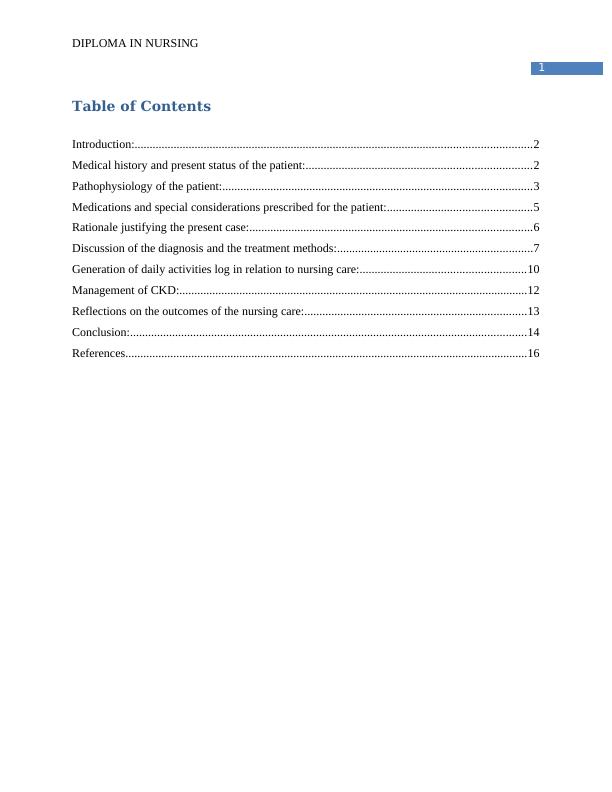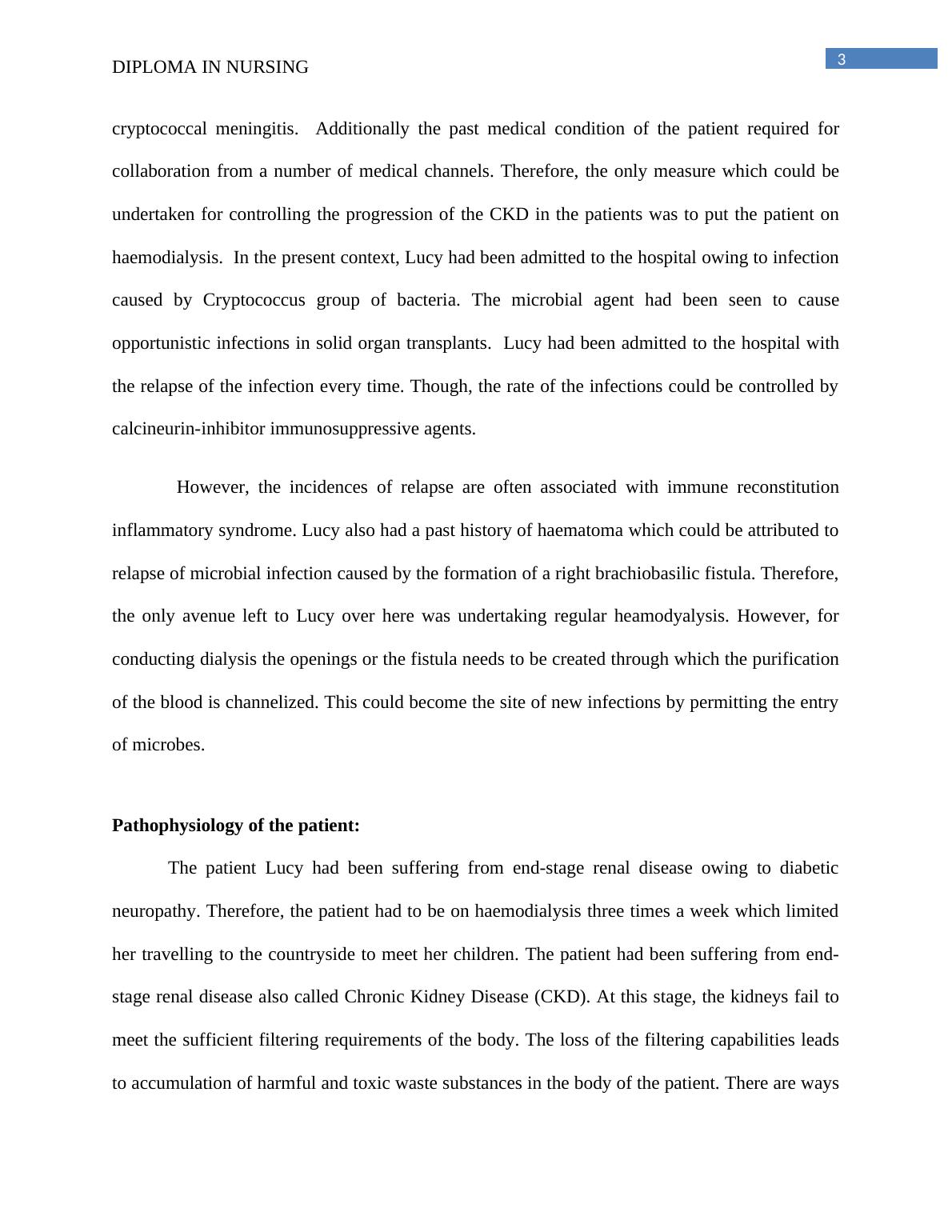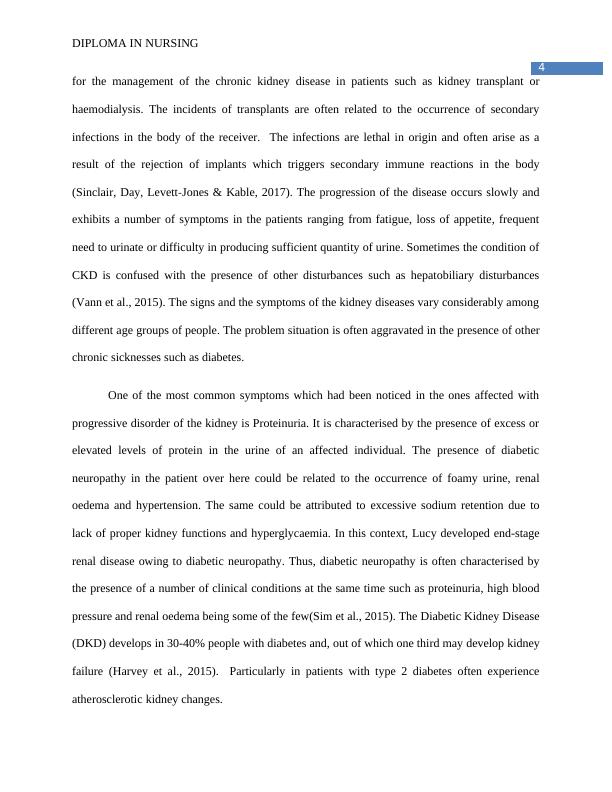Case Study on Diploma of Nursing
Added on 2020-05-11
23 Pages6459 Words37 Views
Running head: DIPLOMA IN NURSING
Diploma in nursing
Name of the student
University name
Author’s note
Diploma in nursing
Name of the student
University name
Author’s note

1
DIPLOMA IN NURSING
Table of Contents
Introduction:....................................................................................................................................2
Medical history and present status of the patient:...........................................................................2
Pathophysiology of the patient:.......................................................................................................3
Medications and special considerations prescribed for the patient:................................................5
Rationale justifying the present case:..............................................................................................6
Discussion of the diagnosis and the treatment methods:.................................................................7
Generation of daily activities log in relation to nursing care:.......................................................10
Management of CKD:....................................................................................................................12
Reflections on the outcomes of the nursing care:..........................................................................13
Conclusion:....................................................................................................................................14
References......................................................................................................................................16
DIPLOMA IN NURSING
Table of Contents
Introduction:....................................................................................................................................2
Medical history and present status of the patient:...........................................................................2
Pathophysiology of the patient:.......................................................................................................3
Medications and special considerations prescribed for the patient:................................................5
Rationale justifying the present case:..............................................................................................6
Discussion of the diagnosis and the treatment methods:.................................................................7
Generation of daily activities log in relation to nursing care:.......................................................10
Management of CKD:....................................................................................................................12
Reflections on the outcomes of the nursing care:..........................................................................13
Conclusion:....................................................................................................................................14
References......................................................................................................................................16

2
DIPLOMA IN NURSING
Introduction:
The current topic focuses on the concept of nursing practices and implementation
strategies which helps in the redressal of the health condition of a patient suffering from chronic
kidney disease. The assignment also takes into consideration end of life palliative care strategies
which helps in easing the pain or alleviated health symptoms faced by the patient. The
assignment emphasizes upon the nursing policies which are relevant in providing long-term care.
The study conducted help in analysing the pathophysiology of the patient and the
relevance of the medical treatment and diagnostic process in comprehending the current problem
situation of the patient. The assignment focuses on Lucy who is a 66-year-old patient and had
been living with her husband and four children. However, Lucy had been restricted to Darwin
owing to her deteriorating health condition. She has to be on constant haemodialysis and repeat
the sessions three times a week. The assignment further emphasizes upon designing daily
activities log which helps in the management of the present condition of the patient. The
reflections also help in understanding the outcomes of the nursing care and designing of alternate
methods.
Medical history and present status of the patient:
In this context, the patient had a plethora of medical conditions and history. Some of
these were coronary artery disease, gout, and type 2 diabetes mellitus. The patient here was on
constant haemodialysis for the past three years owing to end-stage renal failure. The patient had
also undergone thrombectomy and fistuloplasty in the year 2006. The patient had also rejected
graft failure due to immunosuppression and had repeated admission to hospital owing to
DIPLOMA IN NURSING
Introduction:
The current topic focuses on the concept of nursing practices and implementation
strategies which helps in the redressal of the health condition of a patient suffering from chronic
kidney disease. The assignment also takes into consideration end of life palliative care strategies
which helps in easing the pain or alleviated health symptoms faced by the patient. The
assignment emphasizes upon the nursing policies which are relevant in providing long-term care.
The study conducted help in analysing the pathophysiology of the patient and the
relevance of the medical treatment and diagnostic process in comprehending the current problem
situation of the patient. The assignment focuses on Lucy who is a 66-year-old patient and had
been living with her husband and four children. However, Lucy had been restricted to Darwin
owing to her deteriorating health condition. She has to be on constant haemodialysis and repeat
the sessions three times a week. The assignment further emphasizes upon designing daily
activities log which helps in the management of the present condition of the patient. The
reflections also help in understanding the outcomes of the nursing care and designing of alternate
methods.
Medical history and present status of the patient:
In this context, the patient had a plethora of medical conditions and history. Some of
these were coronary artery disease, gout, and type 2 diabetes mellitus. The patient here was on
constant haemodialysis for the past three years owing to end-stage renal failure. The patient had
also undergone thrombectomy and fistuloplasty in the year 2006. The patient had also rejected
graft failure due to immunosuppression and had repeated admission to hospital owing to

3
DIPLOMA IN NURSING
cryptococcal meningitis. Additionally the past medical condition of the patient required for
collaboration from a number of medical channels. Therefore, the only measure which could be
undertaken for controlling the progression of the CKD in the patients was to put the patient on
haemodialysis. In the present context, Lucy had been admitted to the hospital owing to infection
caused by Cryptococcus group of bacteria. The microbial agent had been seen to cause
opportunistic infections in solid organ transplants. Lucy had been admitted to the hospital with
the relapse of the infection every time. Though, the rate of the infections could be controlled by
calcineurin-inhibitor immunosuppressive agents.
However, the incidences of relapse are often associated with immune reconstitution
inflammatory syndrome. Lucy also had a past history of haematoma which could be attributed to
relapse of microbial infection caused by the formation of a right brachiobasilic fistula. Therefore,
the only avenue left to Lucy over here was undertaking regular heamodyalysis. However, for
conducting dialysis the openings or the fistula needs to be created through which the purification
of the blood is channelized. This could become the site of new infections by permitting the entry
of microbes.
Pathophysiology of the patient:
The patient Lucy had been suffering from end-stage renal disease owing to diabetic
neuropathy. Therefore, the patient had to be on haemodialysis three times a week which limited
her travelling to the countryside to meet her children. The patient had been suffering from end-
stage renal disease also called Chronic Kidney Disease (CKD). At this stage, the kidneys fail to
meet the sufficient filtering requirements of the body. The loss of the filtering capabilities leads
to accumulation of harmful and toxic waste substances in the body of the patient. There are ways
DIPLOMA IN NURSING
cryptococcal meningitis. Additionally the past medical condition of the patient required for
collaboration from a number of medical channels. Therefore, the only measure which could be
undertaken for controlling the progression of the CKD in the patients was to put the patient on
haemodialysis. In the present context, Lucy had been admitted to the hospital owing to infection
caused by Cryptococcus group of bacteria. The microbial agent had been seen to cause
opportunistic infections in solid organ transplants. Lucy had been admitted to the hospital with
the relapse of the infection every time. Though, the rate of the infections could be controlled by
calcineurin-inhibitor immunosuppressive agents.
However, the incidences of relapse are often associated with immune reconstitution
inflammatory syndrome. Lucy also had a past history of haematoma which could be attributed to
relapse of microbial infection caused by the formation of a right brachiobasilic fistula. Therefore,
the only avenue left to Lucy over here was undertaking regular heamodyalysis. However, for
conducting dialysis the openings or the fistula needs to be created through which the purification
of the blood is channelized. This could become the site of new infections by permitting the entry
of microbes.
Pathophysiology of the patient:
The patient Lucy had been suffering from end-stage renal disease owing to diabetic
neuropathy. Therefore, the patient had to be on haemodialysis three times a week which limited
her travelling to the countryside to meet her children. The patient had been suffering from end-
stage renal disease also called Chronic Kidney Disease (CKD). At this stage, the kidneys fail to
meet the sufficient filtering requirements of the body. The loss of the filtering capabilities leads
to accumulation of harmful and toxic waste substances in the body of the patient. There are ways

4
DIPLOMA IN NURSING
for the management of the chronic kidney disease in patients such as kidney transplant or
haemodialysis. The incidents of transplants are often related to the occurrence of secondary
infections in the body of the receiver. The infections are lethal in origin and often arise as a
result of the rejection of implants which triggers secondary immune reactions in the body
(Sinclair, Day, Levett‐Jones & Kable, 2017). The progression of the disease occurs slowly and
exhibits a number of symptoms in the patients ranging from fatigue, loss of appetite, frequent
need to urinate or difficulty in producing sufficient quantity of urine. Sometimes the condition of
CKD is confused with the presence of other disturbances such as hepatobiliary disturbances
(Vann et al., 2015). The signs and the symptoms of the kidney diseases vary considerably among
different age groups of people. The problem situation is often aggravated in the presence of other
chronic sicknesses such as diabetes.
One of the most common symptoms which had been noticed in the ones affected with
progressive disorder of the kidney is Proteinuria. It is characterised by the presence of excess or
elevated levels of protein in the urine of an affected individual. The presence of diabetic
neuropathy in the patient over here could be related to the occurrence of foamy urine, renal
oedema and hypertension. The same could be attributed to excessive sodium retention due to
lack of proper kidney functions and hyperglycaemia. In this context, Lucy developed end-stage
renal disease owing to diabetic neuropathy. Thus, diabetic neuropathy is often characterised by
the presence of a number of clinical conditions at the same time such as proteinuria, high blood
pressure and renal oedema being some of the few(Sim et al., 2015). The Diabetic Kidney Disease
(DKD) develops in 30-40% people with diabetes and, out of which one third may develop kidney
failure (Harvey et al., 2015). Particularly in patients with type 2 diabetes often experience
atherosclerotic kidney changes.
DIPLOMA IN NURSING
for the management of the chronic kidney disease in patients such as kidney transplant or
haemodialysis. The incidents of transplants are often related to the occurrence of secondary
infections in the body of the receiver. The infections are lethal in origin and often arise as a
result of the rejection of implants which triggers secondary immune reactions in the body
(Sinclair, Day, Levett‐Jones & Kable, 2017). The progression of the disease occurs slowly and
exhibits a number of symptoms in the patients ranging from fatigue, loss of appetite, frequent
need to urinate or difficulty in producing sufficient quantity of urine. Sometimes the condition of
CKD is confused with the presence of other disturbances such as hepatobiliary disturbances
(Vann et al., 2015). The signs and the symptoms of the kidney diseases vary considerably among
different age groups of people. The problem situation is often aggravated in the presence of other
chronic sicknesses such as diabetes.
One of the most common symptoms which had been noticed in the ones affected with
progressive disorder of the kidney is Proteinuria. It is characterised by the presence of excess or
elevated levels of protein in the urine of an affected individual. The presence of diabetic
neuropathy in the patient over here could be related to the occurrence of foamy urine, renal
oedema and hypertension. The same could be attributed to excessive sodium retention due to
lack of proper kidney functions and hyperglycaemia. In this context, Lucy developed end-stage
renal disease owing to diabetic neuropathy. Thus, diabetic neuropathy is often characterised by
the presence of a number of clinical conditions at the same time such as proteinuria, high blood
pressure and renal oedema being some of the few(Sim et al., 2015). The Diabetic Kidney Disease
(DKD) develops in 30-40% people with diabetes and, out of which one third may develop kidney
failure (Harvey et al., 2015). Particularly in patients with type 2 diabetes often experience
atherosclerotic kidney changes.

5
DIPLOMA IN NURSING
The presence of chronic kidney disease has often been related to other co-morbidities
such as cardiovascular disease as impaired ultrafiltration also affects the rate of circulation.
Additionally, decreased reabsorption of important nutrients from the fluids within the renal distal
convoluted tubules leads to a deficit of some of the important constituents such as calcitriol. The
less concentration of calcitriol further stimulates the synthesis of parathyroid hormones which
leads to increased absorption of calcium from the bones leading to osteoporosis or other bone-
related disorders. Additionally, the presence of co-morbidities such as diabetes further increases
the risk of progressive neuropathy in the patient manifold times (Sinclair et al., 2017).
Medications and special considerations prescribed for the patient:
Lucy had been suggested with a number of different medications for controlling the different co-
morbidities faced by the patient. Some of the medicines which had been suggested to the patient
are aspirin, Calcitriol, 1250 mg oral calcium tablets. Additionally, the patient was also given
folic acid for the restoring and maintaining the blood haemoglobin level. The patient was also
given omeprazole 20 mg oral daily along with daily doses of insulin. The aspirin was suggested
for the prevention of the development of cardiovascular disease in an individual. As asserted by
Hayes, Douglas & Bonner (2015), the presence of chronic kidney disease in an individual could
be related to the development of disease of the coronary arteries. This could be attributed to the
impaired blood ultrafiltration, which also affected the rate of blood circulation. Lucy had also
been substituted with high doses of Calcitriol as the decreased functioning of the proximal
tubules of the kidney lead to less absorption of calcitriol.
The reduction in the amount of calcitriol leads to stimulation of the parathyroid gland
leading to over secretion of para thyroxine. The para thyroxine selectively absorbs calcium from
DIPLOMA IN NURSING
The presence of chronic kidney disease has often been related to other co-morbidities
such as cardiovascular disease as impaired ultrafiltration also affects the rate of circulation.
Additionally, decreased reabsorption of important nutrients from the fluids within the renal distal
convoluted tubules leads to a deficit of some of the important constituents such as calcitriol. The
less concentration of calcitriol further stimulates the synthesis of parathyroid hormones which
leads to increased absorption of calcium from the bones leading to osteoporosis or other bone-
related disorders. Additionally, the presence of co-morbidities such as diabetes further increases
the risk of progressive neuropathy in the patient manifold times (Sinclair et al., 2017).
Medications and special considerations prescribed for the patient:
Lucy had been suggested with a number of different medications for controlling the different co-
morbidities faced by the patient. Some of the medicines which had been suggested to the patient
are aspirin, Calcitriol, 1250 mg oral calcium tablets. Additionally, the patient was also given
folic acid for the restoring and maintaining the blood haemoglobin level. The patient was also
given omeprazole 20 mg oral daily along with daily doses of insulin. The aspirin was suggested
for the prevention of the development of cardiovascular disease in an individual. As asserted by
Hayes, Douglas & Bonner (2015), the presence of chronic kidney disease in an individual could
be related to the development of disease of the coronary arteries. This could be attributed to the
impaired blood ultrafiltration, which also affected the rate of blood circulation. Lucy had also
been substituted with high doses of Calcitriol as the decreased functioning of the proximal
tubules of the kidney lead to less absorption of calcitriol.
The reduction in the amount of calcitriol leads to stimulation of the parathyroid gland
leading to over secretion of para thyroxine. The para thyroxine selectively absorbs calcium from

End of preview
Want to access all the pages? Upload your documents or become a member.
Related Documents
Calcific Uremic Arteriolopathy: Causes, Diagnosis, and Treatmentlg...
|5
|682
|59
Applied Pathophysiology and Pharmacologylg...
|12
|4464
|67
Septic Shock: Deteriorating Patient Case Studylg...
|10
|2760
|327
Journal of Medical Scienceslg...
|16
|5353
|24
Clinical Reasoning Cycle - Doclg...
|9
|2650
|29
Pathophysiology and pharmacology of cerebrovascular accident: A case studylg...
|10
|2676
|244
